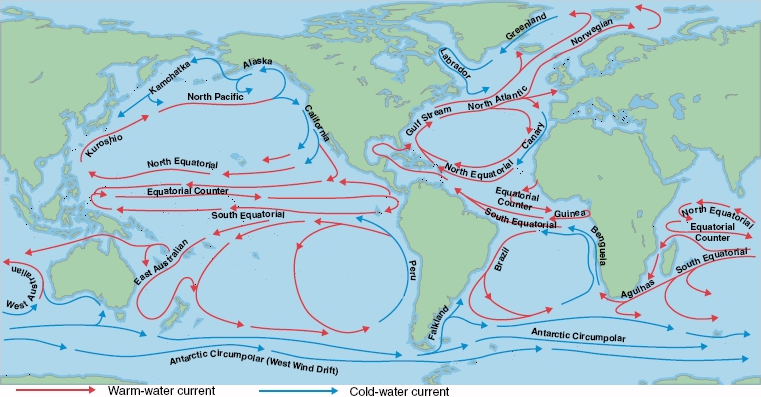Galápagos Islands | 15 Oct 2022
For Prelims: World Heritage Site, Charles Darwin, Cold Ocean currents, Ocean Currents
For Mains: Factors that Influences Ocean Current
Why in News?
According to a recent study, Cold ocean currents have sheltered the Galápagos Islands from global warming.
- The islands are protected from an otherwise warming the Pacific Ocean by a cold, eastward equatorial ocean current.
- The equatorial undercurrent in the Pacific Ocean is bound to the equator by the force of the planet’s rotation. Under the ocean’s surface, a swift circulation of cold, nutrient-rich water flows from west to east.
What is Galapagos Archipelago?
- Location:

- The Galapagos Islands, spread over almost 60,000 sq km, are a part of Ecuador.
- These are located in the Pacific Ocean around 1,000 km away from the South American continent.
- Protection Status:
- Ecuador made a part of the Galapagos a wildlife sanctuary in 1935, and the sanctuary became the Galapagos National Park in 1959.
- In 1978, the islands became UNESCO’s first World Heritage Site.
- Wildlife:
- It contains aquatic species such as manta rays and sharks which have been endangered by commercial fishing.
- It also hosts a wide array of aquatic wildlife, including marine iguanas, and waved albatrosses.
- Galápagos is home to the critically endangered — Galápagos penguin, Galápagos fur seal and Galápagos sea lion.
- Also, the giant tortoises found here – 'Galápagos' in old Spanish – give the islands its name.
- Significance:
- The British naturalist Charles Darwin made key observations in 1835 that shaped his theory of evolution.
- Darwin described the islands as a “world in itself”.
- Corals do not bleach and die in these waters off the west coast of Ecuador.
What are Ocean Currents?
- About:
- Ocean currents are the continuous, predictable, directional movement of seawater. It is a massive movement of ocean water that is caused and influenced by various forces. They are like river flows in oceans.
- Types:
- Cold currents: It brings cold water into warm water areas. These currents are usually found on the west coast of the continents in the low and middle latitudes (true in both hemispheres) and on the east coast in the higher latitudes in the Northern Hemisphere.
- Examples: Canary Current, California Current, Benguela Curren etc.
- Warm currents: It brings warm water into cold water areas and is usually observed on the east coast of continents in the low and middle latitudes (true in both hemispheres).
- Examples: North Atlantic, Gulf Stream, the Kuroshio Current etc.
- Cold currents: It brings cold water into warm water areas. These currents are usually found on the west coast of the continents in the low and middle latitudes (true in both hemispheres) and on the east coast in the higher latitudes in the Northern Hemisphere.
Which are the Factors that Influences Ocean Current?
- Ocean Currents are Influenced by Two types of Forces:
- Primary Forces:
- Heating by solar energy: Heating by solar energy causes the water to expand. That is why, near the equator the ocean water is about 8 cm higher in level than in the middle latitudes. This causes a very slight gradient and water tends to flow down the slope.
- Wind: Wind blowing on the surface of the ocean pushes the water to move. Friction between the wind and the water surface affects the movement of the water body in its course.
- Gravity: Gravity tends to pull the water down the pile and create gradient variation.
- Coriolis Force: The Coriolis force intervenes and causes the water to move to the right in the northern hemisphere and to the left in the southern hemisphere.
- These large accumulations of water and the flow around them are called Gyres.
- These produce large circular currents in all the ocean basins.
- Secondary Forces:
- Differences in Water Density: Water with high salinity is denser than water with low salinity and in the same way cold water is denser than warm water.
- Denser water tends to sink, while relatively lighter water tends to rise.
- Temperature of Water: Cold-water Ocean currents occur when the cold water at the poles sinks and slowly moves towards the equator.
- Warm-water currents travel out from the equator along the surface, flowing towards the poles to replace the sinking cold water.
- Differences in Water Density: Water with high salinity is denser than water with low salinity and in the same way cold water is denser than warm water.
- Primary Forces:
UPSC Civil Services Examination Previous Year Question (PYQ)
Prelims
Q. Consider the following factors: (2012)
- Rotation of the Earth
- Air pressure and wind
- Density of ocean water
- Revolution of Earth
Which of the above factors influence the ocean currents?
(a) 1 and 2 only
(b) 1, 2 and 3 only
(c) 1 and 4 only
(d) 2, 3 and 4
Ans: (b)
Mains
Q. What are the forces that influence ocean currents? Describe their role in fishing industry of the world. (2022)

